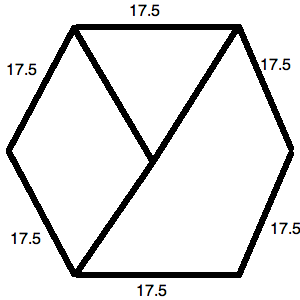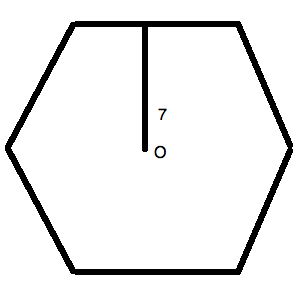All ACT Math Resources
Example Questions
Example Question #31 : Act Math

The figure above is a regular hexagon. is the center of the figure. The line drawn is perpendicular to the side.
What is the perimeter of the figure above?
You can redraw the figure given to notice the little equilateral triangle that is formed within the hexagon. Since a hexagon can have the degrees of its internal rotation divided up evenly, the central angle is degrees. The two angles formed with the sides also are degrees. Thus, you could draw:

Now, the is located on the side that is the same as on your standard triangle. The base of the little triangle formed here is on the standard triangle. Let's call our unknown value .
We know, then, that:
Or,
Now, this is only half of the size of the hexagon's side. Therefore, the full side length is .
Since this is a regular hexagon, all of the sides are of equal length. This means that your total perimeter is or .
Example Question #31 : Geometry
What is the perimeter of a regular hexagon with an area of ?
The area of a regular hexagon is defined by the equation:
, where is the length of a side.
This is derived from the fact that the regular hexagon can be split up into little equilateral triangles, each having an area of
To visualize this, consider the drawing:

Each triangle formed like this will be equilateral. It is easiest to remember this relationship and memorize the general area equation for equilateral triangles. (It is useful in many venues!)
So, for your data, you know:
Solving for , you get:
This means that
Therefore, the perimeter of the figure is equal to or .
Example Question #1 : Hexagons
Find the perimeter of a hexagon with a side length of .
There are 6 sides in a hexagon.
Therefore, given a side length of 16, the perimeter is:
Example Question #31 : Act Math
The side length of a hexagon is . What is the perimeter?
Write the formula for the perimeter of a hexagon.
Substitute the given length.
Example Question #32 : Geometry
The perimeter of a regular hexagon is . What is the length of one of its diagonals?
To begin, calculate the side length of the hexagon. Since it is regular, its sides are of equal length. This means that a given side is or in length. Now, consider your figure like this:

The little triangle at the top forms an equilateral triangle. This means that all of its sides are . You could form six of these triangles in your figure if you desired. This means that the long diagonal is really just or .
Example Question #1 : How To Find The Length Of The Diagonal Of A Hexagon

The figure above is a regular hexagon. O is the center of the figure. The line segment makes a perpendicular angle with the external side.
What is the length of the diagonal of the regular hexagon pictured above?
You could redraw your figure as follows. Notice that this kind of figure makes an equilateral triangle within the hexagon. This allows you to create a useful triangle.

The in the figure corresponds to in a reference triangle. The hypotenuse is in the reference triangle.
Therefore, we can say:
Solve for :
Rationalize the denominator:
Now, the diagonal of a regular hexagon is actually just double the length of this hypotenuse. (You could draw another equilateral triangle on the bottom and duplicate this same calculation set—if you wanted to spend extra time without need!) Thus, the length of the diagonal is:
Example Question #41 : Geometry
If the perimeter of a regular hexagon is , what is the length of a side of that regular hexagon?
Use the formula for perimeter to solve for the length of a side of the regular hexagon:
Where is perimeter and is the length of a side.
In this case:
Example Question #1 : Hexagons
Find the length of one side for a regular hexon with a perimeter of .
Use the formula for perimeter to solve for the side length:
Example Question #2 : Hexagons
Find the length of one side for a regular hexagon with a perimeter of .
Use the formula for perimeter to solve for the side length:
Example Question #2 : Hexagons
What is the maximum length of each side for a regular hexago with a perimeter of ?
8.8
Use the formula for perimeter to solve for the side length:
Certified Tutor
All ACT Math Resources

















































































































